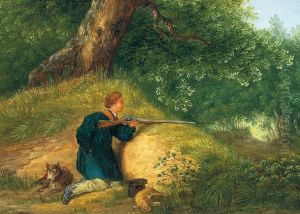Friedrich Joh. G. Lieder Paintings
Friedrich Johann Gottlieb Lieder, also known as Friedrich Lieder the Elder to differentiate him from his son, was an Austrian portrait painter born on February 6, 1780, in Potsdam, then part of the Kingdom of Prussia. Lieder was active during a period that saw the transformation of art with the emergence of Romanticism, yet he is most commonly associated with the Biedermeier movement, a style that depicted bourgeois life and emphasized a sense of order and serenity.
From 1800 to 1803, Lieder studied at the Prussian Academy of Arts in Berlin, where he honed his skills in portrait painting. He then embarked on a journeyman's travels, which was common for artists of the time, moving through various German states and eventually arriving in Vienna in 1806. The cultural scene in Vienna was particularly rich during this period, with the city acting as a hub for musicians, writers, and artists.
Lieder quickly established himself as a sought-after portraitist in Vienna, particularly among the aristocracy and the burgeoning middle class. His ability to capture the likeness and character of his sitters in a realistic yet flattering manner made his work popular. Lieder's portraits are known for their fine detail, clear color palette, and the delicate rendering of fabrics and textures, which reflected the tastes and social status of his clientele.
He became an honorary member of the Vienna Academy in 1827, which was a significant recognition of his artistic contributions. Throughout his career, Lieder created an extensive body of work, including miniatures, which were fashionable at the time. He painted notable figures of the era, thereby documenting the faces of Viennese society during a significant historical period.
Lieder's legacy continued through his family, with his son, Friedrich Lieder the Younger, also becoming a portrait painter. Friedrich Johann Gottlieb Lieder died on October 7, 1859, in Vienna. His portraits remain valuable for their historical significance as well as their artistic merit, providing insight into the aesthetics and societal norms of the Biedermeier period.
